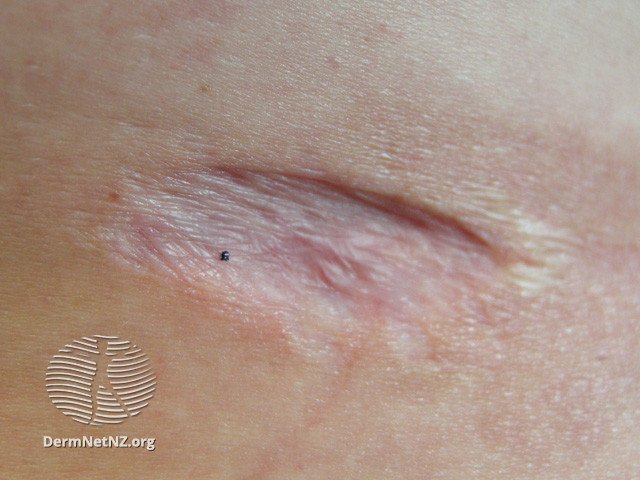
Scars
An atrophic (depressed) scar from a skin cancer removal after the loss of supporting tissue.
Credit: DermNet NZ
What is a scar?
A scar is the body's natural response to trauma, serving as a testament to the skin's healing process. Essentially, scars are fibrous tissues that stand in for damaged skin or other tissues. Scarring is an almost inevitable aftermath of wounds, with collagen – a common component in the skin – making up these fibrous tissues. Unlike natural skin, however, the collagen fibers in scar tissue adopt a different arrangement, bestowing them with distinct appearances and characteristics. Notably, keloids – an overgrowth of scar tissue – represent an extreme form of scarring.
What causes scars?
Scars owe their existence to collagen. But unlike the crisscross alignment in natural skin, collagen in scars arranges in parallel patterns. This divergence gives scar tissue a different texture, strength, and elasticity compared to surrounding skin. Moreover, the absence of hair follicles, sweat glands, and oil glands in scar tissue leads to its unique characteristics. The lack of pigment cells, stemming from missing hair follicles, renders scars more vulnerable to UV damage, potentially leading to nonmelanoma skin cancers.
What are the symptoms of scars?
Scars, for the most part, distinguish themselves through visual differences from adjacent skin. Their potential symptoms, such as dryness, itchiness, pain, or numbness, stem from an absence of oil and sweat glands or disrupted nerve endings. Scars can manifest in several distinct forms, including:
Hypertrophic Scars: Elevated above the skin due to collagen overproduction.
Keloid Scars: An intensified version of hypertrophic scars, notorious for expanding beyond the original injury. These are outlined separately.
Atrophic Scars: These create depressions in the skin, typically from the loss of underlying supportive tissue.
Stretch Marks (Striae): Rapid skin expansion, be it from sudden weight gain, pregnancy, or heightened cortisol levels, can result in these scars.
Umbilical Scars: Universally experienced, these scars mark the spot where the umbilical cord once connected, commonly known as the navel.
How do I treat scars?
While prevention is the most effective strategy, scar treatment predominantly focuses on enhancing their appearance rather than eradicating them. Treatment avenues include:
Subcision
Chemical peels
Filler injections
Microneedling or microdermabrasion
Topical silicone applications
Radiotherapy
How do I prevent scars?
Completely evading scars can be challenging, but certain practices can minimize their prominence:
Addressing conditions that lead to scars or incessant scratching, such as acne, eczema, or lichen simplex chronicus.
Securing wounds in place as they recover, typically through stitches or surgical adhesive.
Practicing meticulous wound care to stave off infections.
Post-wound recovery, harnessing the healing benefits of topical silicone or tretinoin and massaging scars routinely.
A hypertrophic keloid scar on the skin after a lesion removal.
Credit: DermNet NZ
Stretch (striae) marks on the skin from rapid skin expasion.
Credit: DermNet NZ


